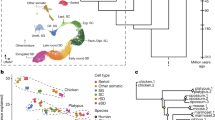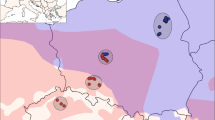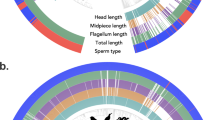Abstract
Postcopulatory sperm competition is a key aspect of sexual selection and is believed to drive the rapid evolution of both reproductive physiology and reproduction-related genes1,2,3,4. It is well-established that mating behavior determines the intensity of sperm competition, with polyandry (i.e., female promiscuity) leading to fiercer sperm competition than monandry1,2,3. Studies in mammals, particularly primates, showed that, owing to greater sperm competition, polyandrous taxa generally have physiological traits that make them better adapted for fertilization than monandrous species, including bigger testes, larger seminal vesicles, higher sperm counts, richer mitochondrial loading in sperm and more prominent semen coagulation2,5,6,7,8. Here, we show that the degree of polyandry can also impact the dynamics of molecular evolution. Specifically, we show that the evolution of SEMG2, the gene encoding semenogelin II, a main structural component of semen coagulum, is accelerated in polyandrous primates relative to monandrous primates. Our study showcases the intimate relationship between sexual selection and the molecular evolution of reproductive genes.
This is a preview of subscription content, access via your institution
Access options
Subscribe to this journal
Receive 12 print issues and online access
$209.00 per year
only $17.42 per issue
Buy this article
- Purchase on Springer Link
- Instant access to full article PDF
Prices may be subject to local taxes which are calculated during checkout



Similar content being viewed by others
References
Karr, T.L. & Pitnick, S. Sperm competition: defining the rules of engagement. Curr. Biol. 9, R787–R790 (1999).
Dixson, A. & Anderson, M. Sexual selection and the comparative anatomy of reproduction in monkeys, apes, and human beings. Annu. Rev. Sex Res. 12, 121–144 (2001).
Birkhead, T.R. & Pizzari, T. Postcopulatory sexual selection. Nat. Rev. Genet. 3, 262–273 (2002).
Swanson, W.J. & Vacquier, V.D. The rapid evolution of reproductive proteins. Nat. Rev. Genet. 3, 137–144 (2002).
Harcourt, A.H., Harvey, P.H., Larson, S.G. & Short, R.V. Testis weight, body weight and breeding system in primates. Nature 293, 55–57 (1981).
Dixson, A.F. Primate Sexuality: Comparative Studies of the Prosimians, Monkeys, Apes, and Human Being (Oxford University Press, New York, 1998).
Dixson, A.L. & Anderson, M.J. Sexual selection, seminal coagulation and copulatory plug formation in primates. Folia Primatol. (Basel) 73, 63–69 (2002).
Anderson, M.J. & Dixson, A.F. Sperm competition: motility and the midpiece in primates. Nature 416, 496 (2002).
Voss, R. Male accessory glands and the evolution of copulatory plugs in rodents. Occ. Pap. Mus. Zool. Univ. Mich. 689, 1–17 (1979).
Kingan, S.B., Tatar, M. & Rand, D.M. Reduced polymorphism in the chimpanzee semen coagulating protein, semenogelin I. J. Mol. Evol. 57, 159–169 (2003).
Dewsbury, D.A. A test of the role of copulatory plugs in sperm competition in deer mice (Peromyscus maniculatus). J. Mammal. 69, 854 (1988).
Michener, G.R. Copulatory plugs in Richardson's ground squirrels. Can. J. Zool. 62, 267–270 (1984).
Blandau, R.J. On factors involved in sperm transport through the cervix uteri of the albino rat. Am. J. Anat. 73, 253–272 (1945).
Mathews, M.K. & Adler, N.T. Systematic interrelationships of mating, vaginal plug position, and sperm transport in the rat. Physiol. Behav. 20, 303–309 (1978).
Dunbar, R.I. & Dunbar, E.P. Contrasts in social structure among black-and-white colobus monkey groups. Anim. Behav. 24, 84–92 (1976).
Rodman, P.S. & Mitani, J.C. Orang-utans: sexual dimorhism in a solitary species in Primate Societies (eds. Smuts, B., Cheney, D., Seyfarth, R., Wrangham, R. & Struhsaker, T.) 146–154 (University of Chicago Press, Chicago, 1987).
Jensen-Seaman, M.I. & Li, W.H. Evolution of the hominoid semenogelin genes, the major proteins of ejaculated semen. J. Mol. Evol. 57, 261–270 (2003).
Yang, Z. Likelihood ratio tests for detecting positive selection and application to primate lysozyme evolution. Mol. Biol. Evol. 15, 568–573 (1998).
Nielsen, R. & Yang, Z. Likelihood models for detecting positively selected amino acid sites and applications to the HIV-1 envelope gene. Genetics 148, 929–936 (1998).
Conoway, C.H. & Koford, C.B. Estrous cycles and mating behavior in a free-ranging band of rhesus monkey. J. Mammal. 45, 577–588 (1965).
Tokuda, K., Simms, R.C. & Jenson, J.D. Sexual behavior in a captive group of pigtail macaque (Macaca nemestrina). Primates 9, 283–294 (1968).
Van Noordwijk, M.A. Sexual behavior of Sumatran long-tailed macaques (Macaca fascicularis). Z. Tierpsychol. 70, 277–296 (1985).
Goodall, J. The Chimpanzees of Gombe: Patterns of Behavior (Harvard University Press, Cambridge, 1986).
Hasegawa, T. & Hiraiwai-Hasegawa, M. Sperm Competition and mating behavior. in The Chimpanzees of the Mahale Mountains: Sexual and Life History Strategies (ed. Nishida, T.) 115–132 University of Tokyo Press, Tokyo, 1990.
Manson, J.H. Mating patterns, mate choice and birth season heterosexual relationships in free-ranging rhesus macaques. Primates 35, 417–433 (1992).
Strier, K.B. Faces in the Forest, the Endangered Muriqui Monkeys of Brazil (Oxford University Press, New York, 1992).
Robert, M. & Gagnon, C. Purification and characterization of the active precursor of a human sperm motility inhibitor secreted by the seminal vesicles: identity with semenogelin. Biol. Reprod. 55, 813–821 (1996).
Lilja, H., Oldbring, J., Rannevik, G. & Laurell, C.B. Seminal vesicle-secreted proteins and their reactions during gelation and liquefaction of human semen. J. Clin. Invest. 80, 281–285 (1987).
Yang, Z. & Nielsen, R. Estimating synonymous and nonsynonymous substitution rates under realistic evolutionary models. Mol. Biol. Evol. 17, 32–43 (2000).
Li, W.H. Unbiased estimation of the rates of synonymous and nonsynonymous substitution. J. Mol. Evol. 36, 96–99 (1993).
Acknowledgements
We thank W.-H. Huang for technical assistance; A. Di Rienzo, C. Malcom, N. M. Pearson, E. J. Vallender and C.-I Wu for discussions and comments on the manuscript; and L.G. Chemnick, A.R. Ryder and L. Faust for providing primate tissue samples. This work was supported in part by the William Rainey Harper Fellowship (to S.D.) and the Searle Scholarship and the Burroughs Wellcome Career Award (to B.T.L.).
Author information
Authors and Affiliations
Corresponding author
Ethics declarations
Competing interests
The authors declare no competing financial interests.
Supplementary information
Supplementary Fig. 1
Lineage-specific ω values of SEMG2 in primates. (PDF 9 kb)
Supplementary Fig. 2
Correlation between the evolutionary rate of SEMG2 and the reproductive behavior/physiology in primates. (PDF 13 kb)
Supplementary Table 1
Likelihood estimates of different evolutionary models. (PDF 9 kb)
Supplementary Table 2
Likelihood ratio between different evolutionary models. (PDF 8 kb)
Rights and permissions
About this article
Cite this article
Dorus, S., Evans, P., Wyckoff, G. et al. Rate of molecular evolution of the seminal protein gene SEMG2 correlates with levels of female promiscuity. Nat Genet 36, 1326–1329 (2004). https://doi.org/10.1038/ng1471
Received:
Accepted:
Published:
Issue Date:
DOI: https://doi.org/10.1038/ng1471
This article is cited by
-
Comparative analysis of sperm motility in liquid and seminal coagulum portions between Bornean orangutan (Pongo pygmaeus) and chimpanzee (Pan troglodytes)
Primates (2021)
-
Population-specific, recent positive directional selection suggests adaptation of human male reproductive genes to different environmental conditions
BMC Evolutionary Biology (2020)
-
Evolutionary analysis of genes coding for Cysteine-RIch Secretory Proteins (CRISPs) in mammals
BMC Evolutionary Biology (2020)
-
The development, evaluation, and illustration of a timeline procedure for testing the role of sperm competition in the evolution of sexual traits using paternity data
Behavioral Ecology and Sociobiology (2020)
-
Genetic and environmental variation in transcriptional expression of seminal fluid proteins
Heredity (2019)



